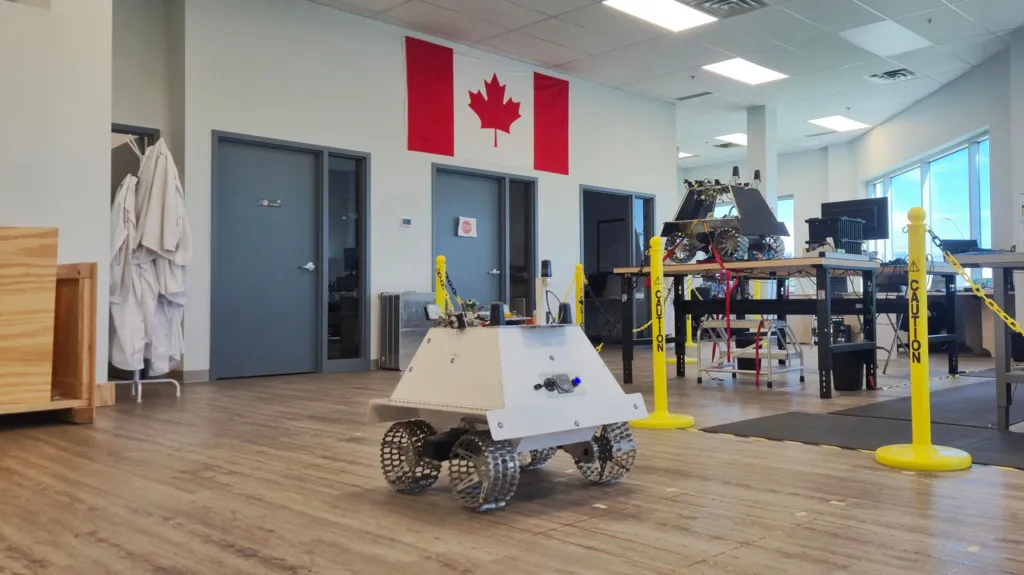Canada’s First Lunar Rover Aims to Pave the Way for Future Space Missions

In an unassuming office park just outside Toronto—next to a day spa and a shawarma shop—Canada is quietly preparing for its most ambitious space mission yet: the country’s first-ever lunar rover.
Inside the headquarters of Canadensys Aerospace, engineers are building what will become the first Canadian-led planetary exploration mission, marking a major milestone in Canada’s space history.
“This is not science fiction. This is the real thing,” said Dr. Christian Sallaberger, Canadensys President and CEO. “We’re laying the groundwork for moving humanity off Earth.”
A Mission With Big Goals
The 35-kilogram rover is being developed as part of NASA’s Artemis program, which aims to establish a sustained human presence on the Moon and eventually launch missions to Mars.
Set to launch no earlier than 2029, Canada’s rover will touch down in the Moon’s South Polar Region, a harsh and scientifically rich area believed to contain water ice—critical for future human settlements.
The rover’s key tasks:
- Search for water
- Measure surface radiation
- Survive extreme lunar conditions, including the 14-day-long freezing nights where temperatures plunge to -200°C
- Showcase Canadian space technologies
“It’s not just about surviving the cold,” said Sallaberger. “The real challenge is the wild temperature swings—from freezing nights to 100°C during the day.”
Building on Canada’s Space Legacy
Canada has long been a contributor to space exploration. It was:
- The third nation to launch a satellite
- The creator of the Canadarm used on NASA’s shuttles and the International Space Station
- Home to astronauts like Chris Hadfield and Jeremy Hansen, who will fly around the Moon on Artemis II in 2026
But this mission marks the first time Canada is leading an extraterrestrial exploration effort.
“The Moon is the next big step,” said Dr. Gordon Osinski, a planetary geologist at Western University and the rover’s chief scientist. “And if we find usable water there, it could change everything.”
Water is heavy and expensive to transport, Osinski noted. But if it’s already on the Moon—possibly as grains of ice embedded in lunar soil—it could support astronauts and be split into hydrogen and oxygen for rocket fuel.
“We’re talking about the Moon as a potential fuel depot. That’s not just sci-fi anymore.”
A Technical Challenge
Canadensys engineers are currently testing multiple prototypes of the rover at their Ontario lab. One of the trickiest problems? Lunar dust, or regolith.
Unlike Earth’s dust, which has been weathered smooth, Moon dust is sharp, jagged, and clingy—what Sallaberger calls “Velcro dirt” that can jam up gears and moving parts.
The rover must also be compact and robust enough to withstand space travel, radiation, and the violent landing process. It will likely be assembled shortly before launch to ensure all components are space-ready.
A Name and a Future
The rover doesn’t yet have a name—the Canadian Space Agency held a public contest and is expected to announce the winner soon.
But for Canadensys, this mission is only the beginning. The company is already working on future concepts like lunar greenhouses, with an eye toward supporting permanent lunar bases.
“If we can build something that survives long-term on the Moon,” Sallaberger said, “it can survive just about anywhere else in the solar system.”
Global Partnerships and a New Space Race
While space exploration has historically been a collaborative domain—epitomized by the International Space Station—new geopolitical tensions are emerging. Questions about resource ownership on the Moon are already being raised.
In response, the Artemis Accords were introduced: a set of principles for peaceful and sustainable space exploration. Over 50 countries, including some surprising names like Uruguay, Estonia, and Rwanda, have signed on.
“There’s a lot more at stake now,” said Osinski. “Space is becoming more accessible, and the Moon is the Holy Grail.”
A Canadian Step into the Future
Canada’s lunar rover may be small in size, but it carries big implications. It’s a leap not just for Canadian space science, but for humanity’s long-term aspirations beyond Earth.
From exploring jagged lunar dust to hunting for water, it’s the start of a new chapter for a country whose space contributions are no longer just behind the scenes.
And it all starts in a building next to a shawarma shop.
